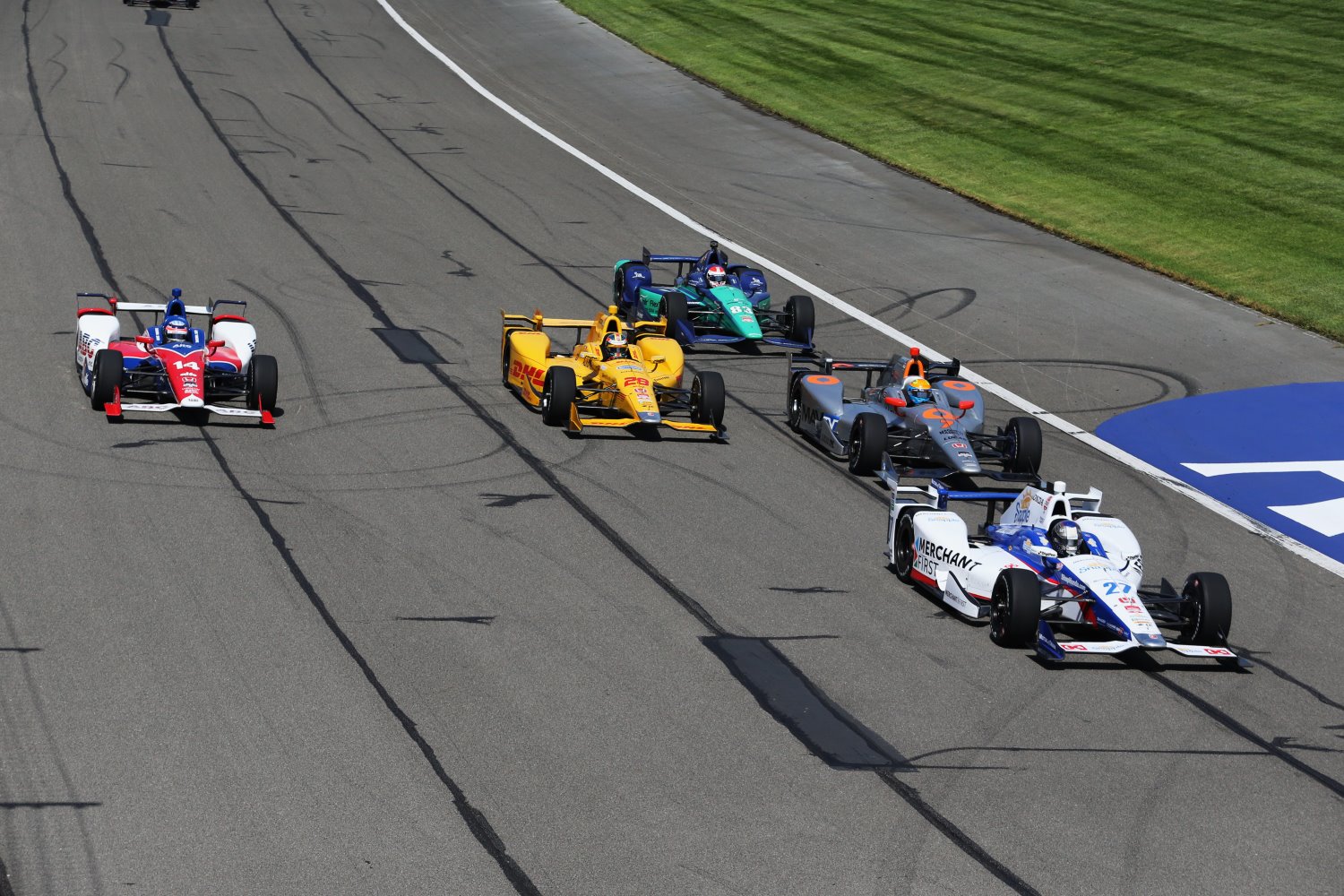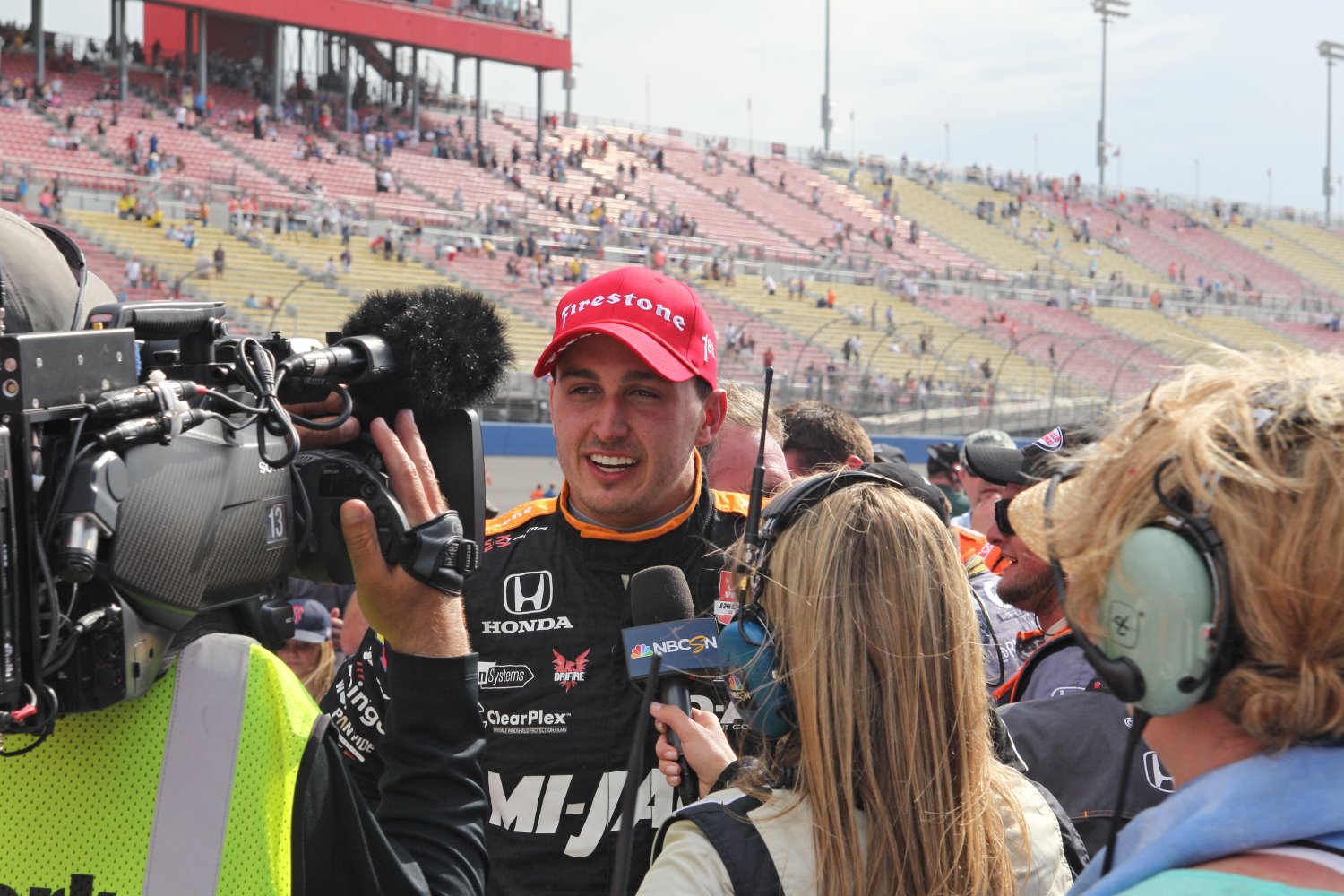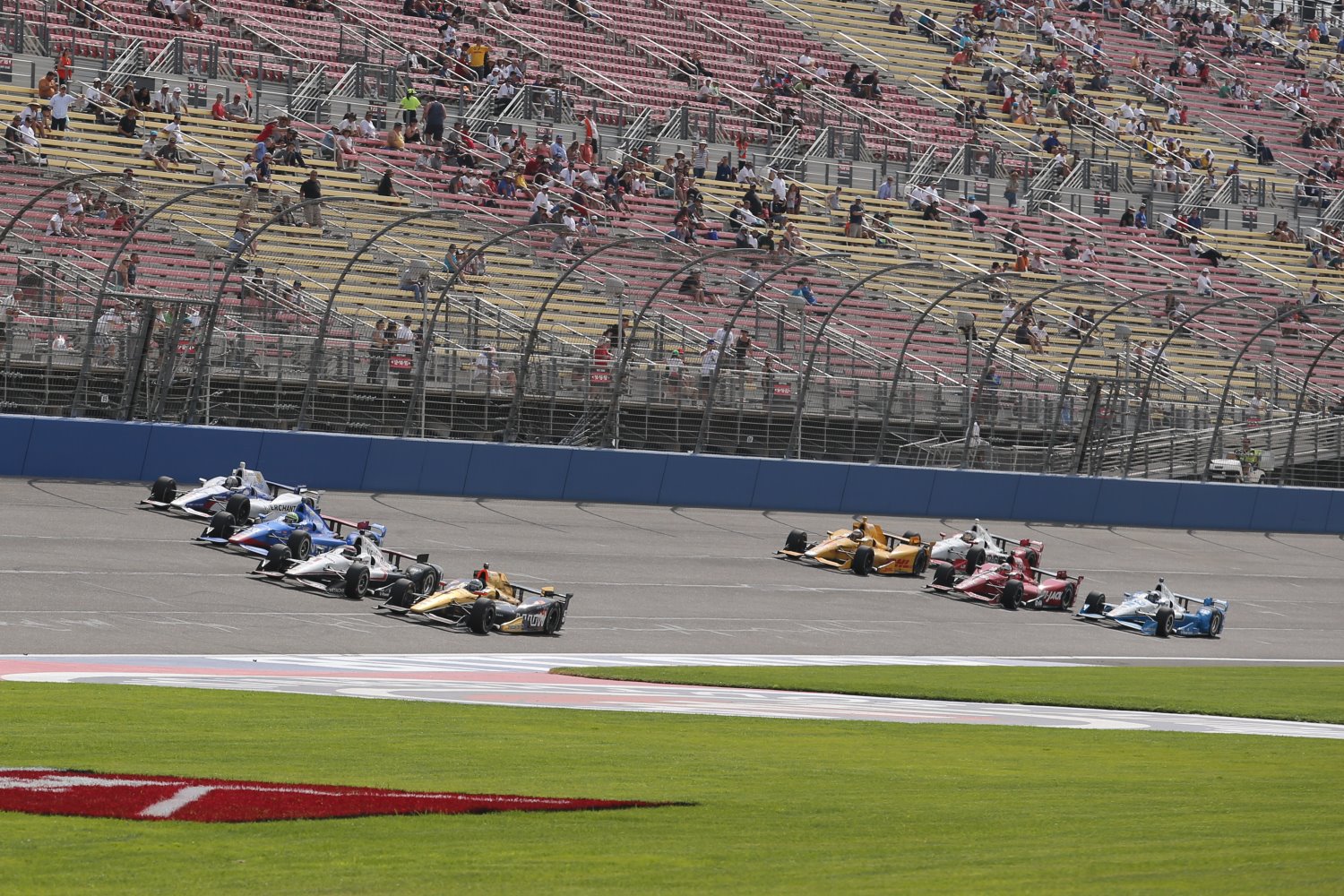IndyCar Fontana postscript
 |
| Close racing was the order of the day |
I wasn't planning to watch Saturday's MAVTV 500. Not live at least.
As you may know, I was at Sonoma Raceway this weekend covering the Toyota/Save Mart 350 NASCAR Sprint Cup Series race. With a checklist of items to complete Saturday, I vowed to focus on the task at hand and 'block out' distractions, one being the Verizon IndyCar Series race at Auto Club Speedway. After all, I could simply watch the recording later that evening. It didn’t exactly work out that way.
As I was in the garage area at Sonoma when the green flag fell at ACS, I began getting text messages about the race. Still, I had garnered some interesting tidbits in the garage, so headed back to the media center focused on writing my report. The messages, however, kept coming.
[adinserter name="GOOGLE AD"]Sometime around lap 30, I decided well, I can just listen to IndyCar radio to check-in and see what’s going on. But like the guy who goes to the bar for one happy hour drink then ends up closing the place down, things got away from me.
Hearing the radio led me inevitably to timing and scoring, then to social media, then to wanting to see a live feed. Not exactly having the gumption to be that guy who asks to watch an IndyCar race in a NASCAR media center, around lap 45 I sent a text to my wife. I needed our Verizon password to set up the streaming. By lap 55 I was logged-in to the NBC Sports live feed. The report would have to wait.
Multiple grooves, multiple leaders, passes high, passes low, cars millimeters apart at over 220 miles per hour, a host of different drivers at the front, and overall drama galore, had my attention. Ultimately, Graham Rahal emerged as the victor in one of the most thrilling IndyCar races I’ve seen.
Of course, it wasn’t all roses
It never is in IndyCar.
While the race may have been entertaining, critics suggested it was a contrived entertainment, which presented an unreasonable level of danger and drifted uncomfortably in the direction of the dreaded ‘pack racing.’ Further, was said level of danger really worthwhile in light of a dismal crowd, paltry purse money and overall diminished commercial state of the series? Did the race have a Gladiators Working for the Circus element as part-time AR1 contributor Keith Ori might suggest? Or are the griping drivers just pampered sissies (some called them worse), whose job is to pipe down and drive the race car?
We’ll try to tackle those questions after we discuss the man who won the MAVTV 500 and the rather bizarre manner in which he won.
 |
| Graham Rahal |
Graham
Rahal’s Odyssey to victory lane after winning at St. Pete seven years ago would probably make a good feature article. Also, the win was Rahal Letterman Lanigan’s first since 2008, something I’m not sure many have mentioned.
For now, it’s not often that one wins a motor race after leaving pit road with his fuel buckeye engaged, depositing said buckeye on the track and causing a caution. But welcome to the bizarre Leviathan that is IndyCar 2015.
Now, before my weekly crush INDYCAR Race Control segment, young Rahal has been far and away the best Honda driver in 2015. If you graded on a curve relative to resources, Rahal has arguably been as good as anyone in the series. Saturday, he displayed all the chutzpah one would associate with winning a dangerous 500-miler.
Of course, in nearly any racing series in nearly any year things probably would have been different. Rahal would have received a penalty for ‘unsafe release’ or some such infraction, and his chances of winning greatly reduced. Rather he is likely to receive some sort of slap on the wrist type measure Wednesday.
In others, Rahal will likely be treated like another 2015 winner. Remember, Juan Pablo Montoya was fined after the Indy 500 when he hit an air hose with no in-race penalty given. While I highly disagree with this approach, the non-penalty on Rahal is consistent with prior precedent established in the warped alternate universe that is IndyCar 2015.
So, I can’t hammer the series here for inconsistency. If anything, it’s their consistency that is the problem. Bizarre!
The Show
Over the past few days, many have devoted great energy to convincing others of their opinion whether the race was good or not, an odd dynamic I will get to.
As for my opinion, it probably wasn’t the purest form of racing. I suppose one could argue (I’m not saying this) Saturday’s race had a supermodels mud wrestling type base appeal, in which you feel somewhat grimy for enjoying yourself, but at the end of the day, you well, enjoy yourself.
Of course, whatever enjoyment there might have been, was not universally shared. And it brought out some of the worst in people.
Danger
 |
| Was it too dangerous? |
Championship-winning drivers such as Will Power, Tony Kanaan and Montoya were very vocal in what they equated to ‘pack racing.’ Said criticisms resulted in strong responses from fans, media, former drivers, current drivers, wannabe drivers, and others, who found the race enjoyable. Although I didn’t see such comments, Robin Miller mentioned in his RACER column that some referred to the drivers as “pussies." Classy!
One credentialed-media member went further, opting to go after the wife of not yet mentioned former IndyCar champion, who tweeted concerns about her perceived dangers of the race. “Maybe you shouldn’t have married a race car driver if you can’t handle close racing," was this genius’ exact quote. Obviously, this lady needed to focus on the “close racing" and not bother others with hysterical concern for the father of her children garbage. I would offer that INDYCAR should re-consider credentialing this individual, but I doubt anything will happen.
Such ignorant thinking, or perhaps better stated, stupidity, tends to be rooted in two things, both of which I find detrimentally prevalent in IndyCar. The first is series cheerleading, in which many media view their role as that of shielding the sport from negative criticism, however reasonable such criticism might be, or without regard for where criticism is rooted. A perfect example would be say, concern for a loved one not tainting one’s potential enjoyment of an automobile race. This idiocy has a trickle-down effect to other constituents in the sport, but that that is a different subject for a different day.
 |
| Racing is a sport and an entertainment business first and foremost. Saturday IndyCar had both. It was great entertainment and it took great skill not to get into trouble while racing wheel-to-wheel at over 200mph |
The second thing that fosters such irrational thinking is the true, although incredibly elementary “they signed up for this" thinking.
Yes, racing is dangerous. Yes, absent any evidence to the contrary no one held a gun to the head of any race car driver to race at Fontana, or I suppose their spouses’ to exchange vows. Yes, drivers are contract employees paid to perform a service – a dangerous one – and yes, it is the series that ultimately decides the rules package, not the drivers.
Still, being a race car driver does not mean one has agreed either explicitly or implicitly to any level or form of danger.
For example, if the series can impose whatever level of danger it sees fit, then why not just ditch the entire car thing, move the next race to the Roman Coliseum and have TK, Power, or JPM wrestle lions? You could even award double-points. I can assure you: TV ratings and attendance would improve.
That’s Preposterous!!!
It’s completely preposterous. But it also illustrates a larger point.
While drivers signed-up for a dangerous activity, they didn’t sign-up for any dangerous activity. They signed-up for a certain level and nature of danger. They also reportedly received assurances from INDYCAR that certain dangers would be avoided. Therefore, if the teams, drivers, or their spouses for that matter, received assurances that were not met, they have every right to be outraged. And that is whether I or anyone else found the race entertaining.
The Better Question
[adinserter name="GOOGLE AD"]Having established that I believe aggrieved drivers are not simply “pussies", the question becomes whether their grievances are warranted, and the danger unreasonable? Chip Ganassi made an interesting point that the drivers had not run a race similar to that in quite a while, which he believes may have elicited some of the reaction.
Granted, I’m not running 215 mph millimeters away from guys named Sato and Coletti. I would also overwhelmingly prefer a high-horsepower lower downforce approach, as we saw in the 1980s and 1990s. Still, from my vantage point, Fontana did not look like ‘pack racing’ a la Las Vegas 2011, which in my opinion has no place in the sport.
At Fontana, cars spread out after a certain number of laps, and the race had one or two hair-raising moments on restarts and such. However, if you re-watch the race, the first half went entirely green and I thought the cars were sufficiently spread out. While the risks would need to be weighed in my opinion this was a form of racing that can differentiate the IndyCar brand and be sold to the public-at-large.
Again, that’s from my vantage point, which is clearly not inside the cockpit of a Dallara.
The Larger Problem
Ultimately, what seems clear is that the series has not defined what its oval racing product will be going forward. One race features excessive downforce, one race there isn’t enough downforce. Fans, drivers, teams, etc. have zero idea what they’re getting race-to-race. In fact, there were rumors and reports Saturday as to what type of racing we might see. That alone tells you there is zero consistency in product presentation, therefore incredibly disparate expectations, therefore conflict, therefore focus on all the wrong things.
Although I believe the analogy to pack racing to be inadequate, that is not for me to decide. The series needs to define its course – whatever that so happens to be – and make that direction clear to fans, sponsors, drivers, teams, etc.
Because think about it: Saturday, a young American with charisma, prodigious bloodlines scored a breakthrough win after years of frustration and heavy criticism in an, frenzied, edge-of-your-seat shootout. He was joined on the podium by another young American with prodigious bloodlines for the first time in their careers. Yet everyone is arguing over what the race should have been, with absolutely zero focus on what it actually was.
That more than anything seems to be problem in a nutshell. That and the fact INDYCAR can’t seem to win, even when it does.
Brian Carroccio is a senior columnist for AutoRacing1. He can be contacted at BrianC@AutoRacing1.com
